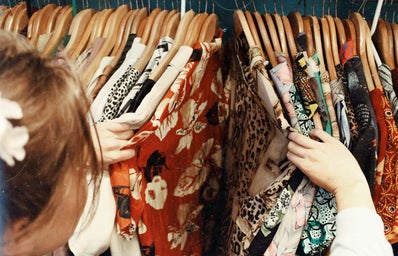Out with the new, in with the old
How thrifting is an environmentally friendly form of resistance to capitalism and fast fashion.
The fashion industry’s problems are beyond what meets the eye on racks, in retail stores and on runways. Fast fashion production perpetuates what experts have termed as ‘modern slavery.’ Clothing manufacturers have violated the human rights of many vulnerable people to reach insurmountable profit goals. The disposal of fast fashion and its waste is a large contributor to environmental decay. Ultimately, fast production leads to fast consumption, which leads to fast disposal – none of which are of benefit to the environment or factory workers. The true cost of fashion is exploitation.
When it is not being gentrified through inflated prices in both physical stores and online platforms such as Instagram, Depop, Etsy and the like, thrifting is a powerful tool of resistance against the harmful industry of fast fashion.
Thrifting serves as a means of curbing the damaging effects of fast fashion while ensuring that all people, particularly low-income and middle-income people, have access to good quality items at affordable prices. Thrifting is purchasing previously owned items that are still in wearable conditions at low costs. Purchasing new clothing is not possible for many people due to socio-economic disadvantages which makes thrifting a necessary act of survival.
An article published by the University of Alabama’s Institute for Human Rights, discussed how clothing companies in the United States have predominantly shifted their manufacturing services from the USA to countries with lenient implementation of labour laws and stifled labour unions. 90% of the clothing consumed in the USA around the 1960s was manufactured within the USA. This has dropped to approximately 3% in the 2010s, meaning an overwhelming majority of clothing that is consumed in the USA is outsourced.
In countries such as Bangladesh and China, labourers have endured horrible working conditions for the lowest compensation. Cheap labour attracts Western countries’ corporations to these countries. Western brands incur shockingly low costs for fast-paced manufacturing and charge decent to high prices for the finished products in their markets, thus, fattening their profit margins. Consumers, in their chase to keep up with evolving trends, purchase clothing at a faster rate for somewhat low prices. Consumers want to keep up with the latest trends and buying into fast fashion is the cheapest way to do so but, at what cost to the exploited humans who toil at the factories? And to what cost to the environment which bears the brunt when these cheap clothing items are discarded as often as they are bought? Although, the consumer is not to blame because a lot of people buy into fast fashion due to its convenient accessibility. These large corporations are the main perpetrators whose insatiable capitalistic appetites are the driving force behind mass production at the expense of humans and the environment.
In 2013, the Rana Plaza building in Dhaka, Bangladesh collapsed. The building was a garment factory for western companies, most popular being Walmart. 1129 workers died and an even larger number of people were injured in the fatal collapse. Factory managers were reportedly warned on multiple occasions of cracks in the infrastructure and an evacuation order was also ignored. The factory workers faced a multitude of struggles from poorly lit working areas which can cause damage to sight; the usage of toxic chemicals harmful to respiratory organs; to extremely unfair compensation. The low standard of living conditions, lack of qualifications and education, limits this country’s citizens employment opportunities exponentially. They have little to no choice but to settle for the exploitative conditions for their own families’ survival.
In their book, Human Trafficking Around the World: Hidden in Plain Sight (2013), Stephanie Hepburn and Rita James Hepburn, wrote on forced labour in China through state-imposed work-study programs. These programmes were allegedly a ‘veiled means to supply school children to factories for forced labour’. There was a case where children under the age of 18 were forced through a government transfer program to work in the Longfa Shoe Factory located in China’s Guangdong Province. This shoe factory was owned by a supplier of footwear to the globally-renowned brand – Nike. The owner being Taiwan-based Dean Shoes Co. Ltd. The co-authors revealed the dangerous conditions the children were forced to work in, along with the excessive hours of labour with mandatory overtime.
Article 23 of the United Nation’s Universal Declaration of Human Rights (UDHR) proclaims that ‘Everyone has the right to work, to free choice of employment, to just and favourable conditions of work and to protection against unemployment. Everyone, without any discrimination, has the right to equal pay for equal work.’ It is a pitiful injustice that this instrument of law is not able to protect those workers in Bangladesh who are being underpaid and the children in China being forced into modern day enslavement in potentially dangerous environments. Article 25 of the aforementioned Declaration is focused on a sufficient standard of living that is enough for an individual to utilise in maintaining their health and well-being. This is only possible through fair compensation which is unfortunately not adhered to in some nations.
Capitalism is vile in that the executives holding senior positions strive to maintain this deeply flawed system with no regard for other human beings contributing vitally to the supply chain. Thrifting could, in one sense, remedy the need for fast-paced manufacturing that takes advantage of socio-economically disadvantaged citizens. On remedying the exploitative effects of capitalism and fashion, Sandrine Charles in a Cosmopolitan Magazine interview suggested “working from the inside. Implementing universal standards around hiring, pay equality, inclusion, and representation means everyone will understand what we need to do.” The only way corporate will take into account the grievances of factory workers especially, is through global collective action. When their margins are affected, businesses tend to listen.
In a UNISA published article from the College of Agricultural & Environmental Sciences titled Fast fashion is the new plastic, Dr Lorna Christie states that: “Globally, clothing production has roughly doubled since 2000. People bought 60% more garments in 2014 compared to the year 2000, and they only kept the clothes for half as long as before. Now, six years later, the fast-fashion cycle has increased even more and it’s safe to say that people are purchasing at an even faster rate too.” The article continues to note that as fast as purchasing takes place, the rate at which the discarding of clothes is at a faster rate too. Dr Christie offers: “We can then continue to wear these clothes for several years, and when they eventually need to be discarded, we can do so responsibly – by recycling, upcycling, donating, and so on. Clothes should only be discarded to a landfill if this is the very last option.”
High-end fashion retailer, Eileen Fisher, made the claim that the clothing industry is “the second-largest polluter in the world.” This statement is justified seeing as 15.1 million tons of textile waste created in 2013 eventually found their way into landfills. These waste piles release methane when they decompose, thus contributing to global warming. Leather tanneries also make use of toxic chemicals in the tanning process which are then incorrectly disposed. This leads to the pollution of drinking water, soil, and the produce of communities surrounding the tanneries. These chemicals are the cause of serious illnesses and diseases.
However, the popularization of thrifting in pop culture has led to excessive consumption which defeats the purpose. Thrifting has been developing into a culture that is glamourized beyond its purpose and in the process, excluding low to middle income folks. The gentrification of thrifting is another injustice permeating the industry.
Nana Agyemang stated that “thrifting is a great workaround for consumers who don’t want to support fast fashion and still need to shop for affordable clothes, but even that’s not ideal for everyone. It can be hard to find the right sizes.” An online trend of thrifting gentrification which has been prominent has been the re-selling of thrifted items on digital social platforms such as Instagram, Facebook, Depop, Etsy and the like. People with the means going to physical thrift stores, purchase items in bulk for low prices, and re-sell the items online at inflated prices. Another thing these folks who unnecessarily bulk-shop at thrift stores are doing, is causing a serious shortage for people whose sizes are not easily available, while also perpetuating capitalistic exclusivity to thrifting.
Fast fashion thrives on a myriad of factors rooted in elitism. Their pricing, worker exploitation, child labour and limited sizing, feeds the beast of capitalism. These issues are trickling into thrifting and need urgent intervention. This is not to say that middle to upper income people who want to get behind sustainable and slow fashion should not thrift to curb the effect of fast fashion on human rights violations and environmental damage. However, it is vital that they do so responsibly and with consideration for others. Thrifting is a great way of hitting fast fashion corporations who thrive on exploitative labour where it hurts.
Assistant Professor Kimberly M Jenkins, stated how “we’ve had so much labour stolen, so much material culture stolen, so much creative genius stolen, and on top of that, we also now have the burden of education” in response to a question about the fashion industry. Adding onto the pile of many reasons fast fashion has proven to be a thief of marginalised cultures. Brands, such as the popular Fashion Nova, has been accused on multiple occasions of creative theft from Black upcoming designers. Jenkins continued to make a blanket statement on fast fashion in which she stated: “It’s so complicated. When sustainable, slow fashion came on the scene it was an elitist style of dressing. Not everyone can afford a 240 Dollar organic sweater, but you have a clean conscious buying it. Now there’s a binary—if you buy slow fashion, you’re a good consumer and if you buy fast fashion, you’re morally corrupt.” This binary of between ‘good’ and ‘bad’ customer could only be justified if sustainable fashions were affordable to everyone. Jenkins went on to rationalize that the blame of fast fashion should not be placed on consumers, but rather ‘at the systemic structures that keep people from making a liveable wage and the companies, which could try to learn a new way to produce ethical, sustainable products at an affordable price point.
85% of the workers in garment industries are reportedly women. Women who have no alternatives to employment, resulting from a shortage in education opportunities and qualifications. Their circumstances forces them to continue labouring in these factories for survival and with hope of ensuring better prospects for their children. This is the true cost of fast fashion, so consume responsibly.


